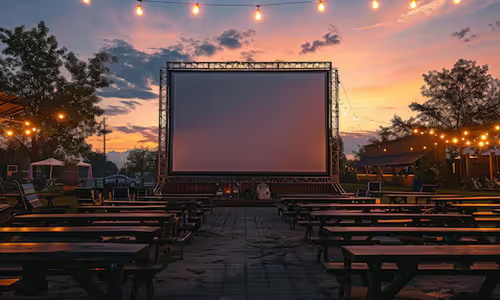回答 The power of the big screen
の回答と詳細な説明 The power of the big screen
Explain
The power of the big screen

A. 1The Lumière Brothers opened their Cinématographe, at 14 Boulevard des Capucines in Paris,to 100 paying customers over 100 years ago, on December 8, 1895. Before the eyes of the stunned, thrilled audience, photographs came to life and moved across a flat screen.
B. So ordinary and routine has this become to us that it takes a determined leap of the imagination to grasp the impact of those first moving images. 6But it is worth trying, for to understand the initial shock of those images is to understand the extraordinary power and magic of cinema, the unique, hypnotic quality that has made film the most dynamic, effective art form of the 20th century.
C. 7One of the Lumière Brothers' earliest films was a 30-second piece which showed a section of a railway platform flooded with sunshine. A train appears and heads straight for the camera. And that is all that happens. Yet the Russian director Andrei Tarkovsky, one of the greatest of all film artists, described the film as a 'work of genius'. 10'As the train approached,' wrote Tarkovsky, 'panic started in the theater: people jumped and ran away. That was the moment when cinema was born. The frightened audience could not accept that they were watching a mere picture. Pictures were still, only reality moved; this must, therefore, be reality. In their confusion, they feared that a real train was about to crush them.'
D. Early cinema audiences often experienced the same confusion. In time, the idea of film became familiar, and the magic was accepted- but it never stopped being magic. Film has never lost its unique power to embrace its audiences and transport them to a different world. 11For Tarkovsky, the key to that magic was the way in which cinema created a dynamic image of the real flow of events.A still picture could only imply the existence of time, while time in a novel passed at the whim of the reader. But in cinema, the real, objective flow of time was captured.
E. 4-8One effect of this realism was to educate the world about itself. Cinema makes the world smaller. Long before people traveled to America or anywhere else, they knew what other places looked like; they knew how other people worked and lived. Overwhelmingly, the lives recorded - at least in film fiction - have been American. From the earliest days of the industry, Hollywood has dominated the world film market. 8American imagery - the cars, the cities, the cowboys - became the primary imagery of film. Film carried American life and values around the globe.
F. And, thanks to film, future generations will know the 20th century more intimately than any other period. We can only imagine what life was like in the 14th century or in classical Greece. But the life of the modern world has been recorded on film in massive, encyclopedic detail. We shall be known better than any preceding generations.
G. The 'star' was another natural consequence of cinema. The cinema star was effectively born in 1910. 5Film personalities have such an immediate presence that, inevitably, they become super-real. Because we watch them so closely and because everybody in the world seems to know who they are, they appear more real to us than we do ourselves. The star as a magnified human self is one of cinema's most strange and enduring legacies.
H. 9Cinema has also given a new lease of life to the idea of the story. When the Lumière Brothers and other pioneers began showing off this new invention, it was by no means obvious how it would be used. All that mattered at first was the wonder of movement. 12Indeed, some said that, once this novelty had worn off, cinema would fade away. It was no more than a passing gimmick, a fairground attraction.
I. 2Cinema might, for example, have become primarily a documentary form. Or it might have developed like television - as a strange, noisy transfer of music, information and narrative.But what happened was that it became, overwhelmingly, a medium for telling stories. Originally these were conceived as short stories - early producers doubted the ability of audiences to concentrate for more than the length of a reel. Then, in 1912, an Italian 2-hour film was hugely successful, and Hollywood settled upon the novel-length narrative that remains the dominant cinematic convention of today.
J. 3And it has all happened so quickly. Almost unbelievably, it is a mere 100 years since that train arrived and the audience screamed and fled, convinced by the dangerous reality of what they saw, and, perhaps, suddenly aware that the world could never be the same again - that, maybe, it could be better, brighter, more astonishing, more real than reality. 13
Questions 1 - 5:
Reading Passage 1 has ten paragraphs, A-J. Which paragraph contains the following information?
Write the correct letter, A-J, in boxes 1 - 5 on your answer sheet.
Questions 6 - 9:
Do the following statements agree with the views of the writer in Reading Passage 1?
In boxes 6 - 9 on your answer sheet, write
YES if the statement agrees with the views of the writer
NO if the statement contradicts the views of the writer
NOT GIVEN if it is impossible to say what the writer thinks about this
6
Questions 10 - 13:
Choose the correct letter. A, B, C, or D.
Write the correct letter in boxes 10 - 13 on your answer sheet.
![[Recent Tests- VOL] - A Brief Introduction to Pepper](https://static.helik.app/reading/2250f746-b094-476e-a25e-a47a21c27072)
![[Recent Tests- VOL] - Classifying societies](https://static.helik.app/reading/e93c3418-dcc0-4095-96eb-ee3951a68289)
![[Recent Tests- VOL] - The Blockbuster Phenomenon](https://static.helik.app/reading/2f76f74f-39e0-45b8-8c43-ff5bac22ee2b)
![[Recent Tests- VOL] - Saving the Bittern](https://static.helik.app/reading/4f428d53-643b-477c-afb1-d6f0cee2e8fb)
![[Recent Tests- VOL] - Ambergris](https://static.helik.app/reading/b6be70ec-fa99-41ea-876e-4058cfbab0cd)
![[Recent Tests- VOL] - Developmental Tasks of Normal Adolescence](https://static.helik.app/reading/69287e43-4020-4dea-9c3e-54bc2c48bab8)
![[Recent Tests- VOL] - Corporate Social Responsibility](https://static.helik.app/reading/4034faff-df5e-4727-af9c-fe17355ea7eb)
![[Recent Tests- VOL] - Amateur Naturalists](https://static.helik.app/reading/9177a84f-590c-4379-b00a-5c18b76c217d)